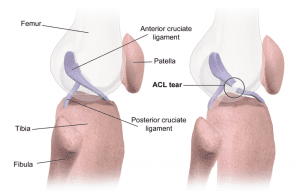Welcome to this week’s edition of the Robbins Rehabilitation blog.
Today, we are going to focus on a hot topic: ACL Injuries.
Anterior cruciate ligament (ACL) injuries seemed to be the talk of the year, especially if you’re an Eagles fan who went through the midseason drama of watching starting quarterback Carson Wentz end his season with an ACL tear. This blog post will serve to provide you with a general idea of what and where the ACL is, what it does, how it’s injured, types of injuries, and the general rehabilitation process. Finally, at the end of the blog, we’ll provide you with some resources that will serve to be invaluable for you in regards to reducing the risk of having this injury occur to you.
What is the ACL and what does it do?
The ACL is one member of a pair of cruciate ligaments that cross through each knee. The ACL runs diagonally through the middle of the knee, serving a number of important functions of the knee, including: preventing the forward slide of the tibia (lower leg leg bone) on the femur (upper leg bone), backward slide of the femur on the tibia, and providing rotational stability to the knee during dynamic tasks.

How does the ACL get injured?
The ACL can be injured in a number of ways and the causes are typically non-contact in nature. These causes include a rapid change in direction, poor landing mechanics after a jump, and slowing down or stopping suddenly while running. While approximately ~70% of ACL injuries do occur in a non-contact fashion, direct collisions with the knee can also cause injury to the ACL. Additionally, females appear to be more susceptible to ACL tears than male counterparts, due to a number of anatomical and biomechanical differences continuing to be studied through the literature, such as hamstring activation and relative strength ratios between muscle groups.
Are all ACL injuries the same?
ACL injuries can be classified based upon their severity. While all individuals are unique and specificities will vary, these classifications will help determine the healing potential and timeframe of their injury, barring additional injuries sustained to the individual.
Grade 1 Sprain: Mild damage to the ligament was done in the form of excessive stretching; however, knee should still retain joint stability.
Grade 2 Sprain: Often referred to as a “partial tear,” the ligament becomes stretched to the point where joint instability often occurs.
Grade 3 Sprain: Known as a “complete tear” of the ligament, the ligament itself is severed and the knee is highly unstable.
What happens when an injury occurs?
The specifics of what happens post-injury will change given the individual’s injury and overall status; however, complete tears of the ACL will often require surgical intervention to correct, especially amongst more active individuals. While general functionality will be restored in a much shorter period of time, athletes can generally expect 9-12+ months before being able to return to high level sporting activities without fear of re-injury occurring.
Whether a surgical intervention is performed or not, rehabilitation services in the form of physical therapy will play a vital role in both restoring your functionality and ensuring that injury does not occur again. A skilled physical therapy routine will ensure that motion will be restored through the joint, followed by strengthening and stabilization of surrounding musculature, and finally restore you to your optimal goal levels of functionality.
Are there any ways to reduce the risk of injury to the ACL?
Absolutely! There are a number of proven methods available to reduce the risk of an individual sustaining an ACL injury. We here at Robbins Rehabilitation in Lehigh Valley established a task force, with the purpose of identifying and establishing routines that will help prevent these very injuries.
For those of you seeking additional ways to further your knowledge concerning ACL injuries, and to reduce risk of injury, click the following link to find more in-depth information regarding our ACL injury prevention program and how you can utilize these methods in your everyday training: https://robbinsptwest.com/acl
If you are injured and are ready to get started right away on the rehabilitation process, then do not hesitate to give a call at 610-841-3555.
That’s all for now! Feel free to post any questions in the comments section below and if you sign up for a course you will be able to get to stay on top of all things Robbins Rehab!

